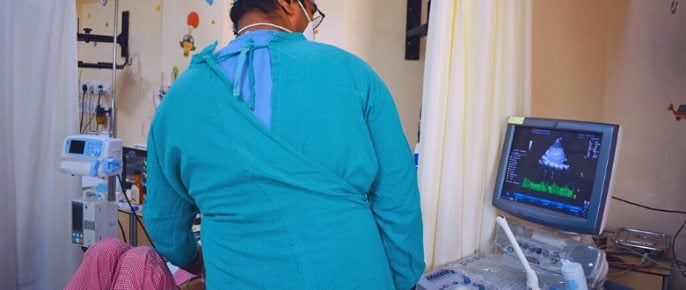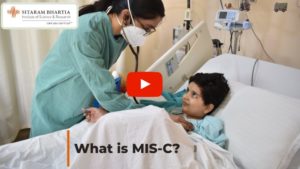As the second wave of COVID-19 began to peter out in India, post COVID-19 effects began to roll in, with Mucormycosis/black fungus and now MIS-C.
A total of 177 MIS-C cases were reported in Delhi NCR, around May 29, 2021 and the condition has since begun to crop up in other states.
Though not contagious, MIS-C requires early attention. Our team of pediatricians at Sitaram Bhartia Institute of Science and Research explain the details.
What is MIS-C?
This illness, called the MIS-C or multi-system inflammatory syndrome, is a manifestation of a combination of behaviours/complaints which are related to the presence of inflammations or swellings in a lot of organ systems.
This is being increasingly seen in children who were COVID positive. They could have been asymptomatic or even symptomatic. After examining a lot of these children, correlating the lab parameters and the presence of insults or injuries in the body, we are seeing an emergence of swellings sometimes in the child’s heart, gut and joint areas. Accordingly, these children need to be detected in time, so that it can lead to early intervention which leads to good outcomes.
“If your child had COVID-19, or was exposed to a COVID positive family member, especially during this second wave, look out for certain signs and take note early, “ says Dr. Neha Joshi, Consultant, Pediatrics.
What are the symptoms of MIS-C?
This is being increasingly seen in children who had an experience with COVID, regardless of whether they were symptomatic or not.
There seems to be an emergence of complaints or symptoms after a gap of 2 to 6 weeks (of the exposure to COVID themselves, or to a COVID positive family member), which can sometimes extend upto 8 to 12 weeks.
At this point in time, all families, who have had an experience with COVID in the recent past, especially in the second wave have to watch out for
- Fever
- Pain in the hands, swelling in the hands and feet
- Severe belly pain
- Accompanying vomit
- Diarrhea
- Red eyes
- Red oral cavity which is a red tongue
Some children may have nodular swellings in some parts of their body.
Even just high fever by itself warrants close observation for the high likelihood of this syndrome.
Dr. Abhishek Chatterjee, Attending Consultant, Pediatrics explains how the condition can be managed once diagnosed.
How is MIS-C treated?
In cases of MIS-C, children have to be admitted in the Pediatric Intensive Care Unit (PICU) and may not be managed in OPD care or at home. Children may require steroids and or intravenous immunoglobulin along with other symptomatic treatment.
It is understandable to question why children will require intensive care. Dr. Anirban Mandal, Attending Consultant, Pediatrics, discusses the answer.
Why do children require intensive care with MIS-C?
Children with MIS-C are frequently quite ill and require a multi-pronged approach. Therefore, a team of skilled personnel, from different specialties, not only pediatrics or pediatric intensivists but sometimes cardiologists or pediatric surgeons are required. There are also some specialized equipment that are required for monitoring and treatment.
At Sitaram Bhartia Hospital in South Delhi, we have a dedicated team as well as necessary, state of the art equipment in place.
What kind of interventions are undertaken in the PICU?
Like any other clinical condition, the management of MIS-C also depends on the clinical severity and manifestation of the disease. As its name suggests, it involves multiple organ systems in the body, and therefore, we have to give supportive therapy to all the organ systems involved till the time our specific medications, that is, our anti-inflammatory medications start having an effect.
To clarify further, in most of the cases of MIS-C, there is involvement of the heart. So in diagnostic studies of the heart, we would require an ECG, an echo cardiogram, which would be repeated at certain intervals to see the effect of the disease. There will be continuous monitoring of the ECG as well, and if at any time there is a decrease in the cardiac function or there are rhythm disturbances of the heart, we would have to give specific medications, which are given through the intravenous route.
Other systems involved in MIS-C are the blood vessels, the blood itself, the gastrointestinal system and if it progresses, then there may be involvement of the kidney and the brain. In these cases, when the child’s blood pressure is not maintained, we have to give medications to maintain the blood pressure. If blood product transfusions are required, then we have to give blood product transfusions. Along with this, we have to give specific medications such as steroids, the intravenous immunoglobulin, aspirin, blood thinners or low molecular heparins.
There are many medications and so we may require what is called as a Central Venous Access, which is a special IV access and bigger than the regular IV cannula that is used. This is inserted either in the neck or in the thighs, into the bigger veins of the body, whereby we can infuse multiple medications at one go and without much intervention. It is done by experienced pediatric surgeons under ultrasound guidance. This central venous line also helps in monitoring the pressures within the heart, which becomes important when the heart is not functioning well.
Conclusion
Don’t be discouraged as the condition can be managed provided it is noticed early on. Watch Vihaan Chaturvedi, 6 years and his aunt share their journey as he prepared to return home after a week-long fight with MIS-C.
You May Like to Read:



